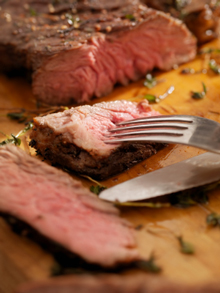Red Meat-Heart Disease Link Involves Gut Microbes
Red Meat-Heart Disease Link Involves Gut Microbes
The link between red meat consumption and heart disease, a study suggests, may stem from gut microbes breaking down carnitine, a compound found in red meat.
People who eat a lot of red meat have an increased risk for cardiovascular disease. The saturated fats and cholesterol in meat are thought to be culprits. But they can’t fully account for the association, suggesting that other factors may be involved.
The digestive system is home to trillions of microbes. These microbes, collectively known as the microbiota, help break down our food, forming a variety of small compounds in the process. One of these compounds is trimethylamine, which can be metabolized to form trimethylamine-N-oxide (TMAO). TMAO has been associated with atherosclerosis, a disease in which plaque builds up inside the arteries.
A team led by Dr. Stanley L. Hazen and Robert A. Koeth of the Cleveland Clinic thought there might be a link between heart disease and the compound carnitine, which is abundant in red meat and contains a trimethylamine structure. Their research was funded in part by NIH’s National Heart, Lung and Blood Institute (NHLBI) and Office of Dietary Supplements (ODS). The findings appeared online on April 7, 2013, in Nature Medicine.
When the scientists asked people to consume a beef steak and a carnitine supplement, regular meat eaters produced more TMAO than vegans or vegetarians. When participants took antibiotics to suppress gut microbes, they produced less TMAO after eating carnitine. This suggests that gut microbes are involved in the production of TMAO from carnitine.
The team assessed the types of microbes in the participants’ digestive systems and discovered differences between the meat eaters and non-meat eaters. They also found links between carnitine consumption and plasma TMAO levels, suggesting that eating habits may influence gut microbiota and thus the ability to form TMAO from carnitine.
The team next examined about 2,600 patients undergoing cardiac evaluations. They found that plasma carnitine levels were associated with the risk for heart disease and cardiac events such as heart attack, stroke and death. These relationships only held in people with high TMAO levels, suggesting that TMAO is a key link between carnitine and cardiovascular risk.
To investigate further, the researchers studied germ-free mice with no pre-existing gut microbiota. They found that these mice didn’t make TMAO when first fed carnitine. However, when the mice were allowed to acquire conventional microbiota, carnitine feeding then led to TMAO formation.
Mice fed a diet supplemented with carnitine for several months showed evidence of altered intestinal microbes, a greater ability to produce TMAO from carnitine, and increased atherosclerosis. Parallel mice fed the same diet but given an antibiotic to suppress gut microbiota had lower plasma TMAO and no increase in atherosclerosis. In further experiments, the researchers found that TMAO affects a major pathway for clearing cholesterol from the body, providing a potential mechanism for how TMAO might promote atherosclerosis.
These findings could help explain the elevated health risks associated with red meats. “The composition of bacteria living in our digestive tracts is dictated by our long-term dietary patterns,” says Hazen. “A diet high in carnitine actually shifts our gut microbe composition to those that like carnitine, making meat eaters even more susceptible to forming TMAO, which helps promote atherosclerosis.”
By Carol Torgan, Ph.D.
###
* The above story is reprinted from materials provided by National Institutes of Health (NIH)
** The National Institutes of Health (NIH) , a part of the U.S. Department of Health and Human Services, is the nation’s medical research agency—making important discoveries that improve health and save lives. The National Institutes of Health is made up of 27 different components called Institutes and Centers. Each has its own specific research agenda. All but three of these components receive their funding directly from Congress, and administrate their own budgets.




















